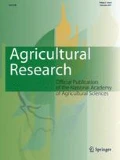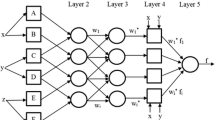Abstract
Mechanization is a concept and cannot be measured directly, so we used appropriate indicators in order to determine mechanization status for the first time in this field of study. In this paper, based on energy and power availability, four indicators, namely machinery energy ratio, mechanization index, productivity level of consumed power, and mechanization level, were selected for assessing agricultural mechanization in potato production of Iran using integrated assessment and modeling (IAM) to provide insight into the potential impacts of policy changes. To do an IAM in agricultural mechanization, we used pervasive analysis using more than 90 features in sample farms. This IAM is the first generalized model in agricultural mechanization. The main purpose of this study is presenting and showing capability of ANNs to model agricultural mechanization status and indicating best ANN model. Finally, a two hidden layer model with these features showed best performance: generalized feed-forward network with Levenberg Marquart learning rule and Bias Axon transfer function with 4–10 neurons in two hidden layers which have 27 input items for modeling four outputs. In this study, ANN models were introduced and applied to help IAM investigation which integrating production factors to have better knowledge about agricultural system of potato production in a wide region.













Similar content being viewed by others
Abbreviations
- ANN:
-
Artificial neural networks
- Ax:
-
Axon (transfer function of ANN)
- BA:
-
BiasAxon (transfer function of ANN)
- CG:
-
ConjugateGradient (learning rule of ANN)
- DBD:
-
DeltaBarDelta (learning rule of ANN)
- GFF:
-
Generalized feed-forward
- IAM:
-
Integrated assessment and modeling
- LA:
-
LinearAxon (transfer function of ANN)
- LM:
-
LevenbergMarquar (learning rule of ANN)
- LSA:
-
LinearSigmoidAxon (transfer function of ANN)
- LTA:
-
LinearTanhAxon (transfer function of ANN)
- MAE:
-
Mean absolute error
- MER:
-
Machinery energy ratio
- MI:
-
Mechanization index
- ML:
-
Mechanization level
- MLP:
-
Multi layer perceptron
- MoM:
-
Momentum (learning rule of ANN)
- MSE:
-
Mean squared Error
- NMSE:
-
Normalized mean squared error
- PLCP:
-
Productivity level of consumed power
- QP:
-
Quickprop (learning rule of ANN)
- R 2 :
-
Coefficent of determination
- SA:
-
SigmoidAxon (transfer function of ANN)
- SMA:
-
SoftMaxAxon (transfer function of ANN)
- TA:
-
TanhAxon (transfer function of ANN)
References
Abdullakasim W, Koike M, Takigawa T, Hasegawa H, Yoda A, Bahalayodhin B (2005) Agroproductivo del estado de Guanajuato. SICOPOT-GTO. Guanajuato. México (CD-ROM In Spanish)
Andrade P, Jenkins BM (2003) Identification of patterns of farm equipment utilization in two agricultural regions of central and northern Mexico. Agric Eng Int 5:276–288
Anonymous (2012). www.neurosolutions.com/products/nsexcel/. Retrieved at 2012-01-12
Chester J (1993) Neural networks: a tutorial. Prentice Hall, New York
Collado M, Calderón E (2000) Energía de utilizada para la producción agrícola en el estado de Guanajuato: Cuantificación y análisis. Memorias del III Congreso Latinoamericano de Ingeniería Agrícola. Guanajuato. México (In Spanish)
Drummond ST, Sudduth KA, Joshi A, Birrel SJ, Kitchen NR (2003) Statistical and neural methods for site-specific yield prediction. Trans ASAE 46(1):5–14
Ewert F, van Ittersum MK, Bezlepkina I, Therond O, Andersen E, Belhouchette H, Bockstaller C, Brouwer F, Heckelei T, Janssen S, Knapen R, Kuiper M, Louhichi K, Alkan Olsson J, Turpin N, Wery J, Wien JE, Wolf J (2009) A methodology for enhanced flexibility of integrated assessment in agriculture. Environ Sci Policy 12(2009):546–561
Fischer G, Shah MN, Tubiello F, van Velhuizen H (2005) Socio-economic and climate change impacts on agriculture: an integrated assessment, 1990–2080. Philos Trans R Soc B 360(1463):2067–2083
García H, García OJ, Ramírez A (2005) INIFAP. Sistema de consulta del potencial
Gifford RC, Rijk AG (1980) Guidelines for agricultural mechanization strategy in development. Economic and Social Commission for Asia and the Pacific (ESCAP), Regional Network for Agricultural Machinery
Giles GW (1975) The reorientation of agricultural mechanization for the developing countries. FAO Report on Effect of Farm Mechanization on Production and Employment. Food and Agricultural Organization (FAO), Rome, Italy
Grübler A (1998) Technology and global change. Cambridge University Press, Cambridge
Harris G (2002) Integrated assessment and modelling—science for sustainability. In: Costanza R, Joergensen SE (eds) Understanding and Solving Environmental Problems in the 21st Century. Elsevier, Amsterdam, pp 5–17
Höchtl F, Lehringer S, Konold W (2005) Wilderness: what it means when it becomes a reality—a case study from the southwestern Alps. Landsc Urban Plan 70:85–95
Holzschuh A, Steffan-Dewenter I, Tscharntke T (2010) How do landscape composition and configuration, organic farming and fallow strips affect the diversity of bees, wasps and their parasitoids? J Anim Ecol 79:491–500
Hornik K, Stinchcombe M, White H (1989) Multilayer feedforward networks are universal approximators. Neural Netw 2:359–366
Jongman RHG (2002) Homogenisation and fragmentation of the European landscape: ecological consequences and solutions. Landsc Urban Plan 58:211–221
Klimek S, Richtergen A, Kemmermann A, Hofmann M, Isselstein J (2007) Plant species richness and composition in managed grasslands: the relative importance of field management and environmental factors. Biol Conserv 134:559–570
Maurer K, Weyand A, Fischer M, Stöcklin J (2006) Old cultural traditions, in addition to land use and topography, are shaping plant diversity of grasslands in the Alps. Biol Conserv 130:438–446
NCAER (1981) Implication of tractorisation for farm employment, productivity and income. National Council of Applied Economic Research, Parisila Bhawan, New Delhi
Oida A (2000) Agricultural machinery management using personal computer (Text & Practice). Agricultural Machinery Management Course organized by Japan International Cooperation Agency, Japan
Parker P, Letcher R, Jakeman A, Beck MB, Harris G, Argent RM, Hare M, Pahl-Wostl C, Voinov A, Janssen M, Sullivan P, Scoccimarro M, Friend A, Sonnenshein M, Baker D, Matejicek L, Odulaja D, Deadman P, Lim K, Larocque G, Tarikhi P, Fletcher C, Put A, Maxwell T, Charles A, Breeze H, Nakatani N, Mudgal S, Naito W, Osidele O, Eriksson I, Kautsky U, Kautsky E, Naeslund B, Kumblad L, Park R, Maltagliati S, Girardin P, Rizzoli A, Mauriello D, Hoch R, Pelletier D, Reilly J, Olafsdottir R, Bin S (2002) Progress in integrated assessment and modelling. Environ Model Softw 17(3):209–217
Pearce D (2005) What constitutes a good agro-environmental policy evaluation? In: OECD (ed) Evaluating agri-environmental policies. design, practice and results. OECD, Paris, pp 71–97
Rijk AG (1989) Agricultural mechanisation policy and strategy—the case of Thailand. Asian Productivity Organisation, Tokyo
Ripoll-Bosch R, Díez-Unquera B, Ruiz R, Villalba D, Molina E, Joy M, Olaizola A, Bernués A (2012) An integrated sustainability assessment of mediterranean sheep farms with different degrees of intensification. Agric Syst 105:46–56
Roschewitz I, Gabriel D, Tscharntke T, Thies C (2005) The effects of landscape complexity on arable weed species diversity in organic and conventional farming. J Appl Ecol 42:873–882
Rotmans J, van Asselt M (1996) Integrated assessment:growing child on its way to maturity—an editorial essay. Clim Chang 34:327–336
Rotmans J, Deboois H, Swart RJ (1990) An integrated model for the assessment of the greenhouse-effect—the Dutch Approach. Clim Chang 16(3):331–356
Schmitzberger I, Wrbka T, Steurer B, Aschenbrenner G, Peterseil J, Zechmeister HG (2005) How farming styles influence biodiversity maintenance in Austrian agricultural landscapes. Agric Ecosyst Environ 108:274–290
Schönhart M, Schauppenlehner T, Schmid E, Muhar A (2011) Integration of bio-physical and economic models to analyze management intensity and landscape structure effects at farm and landscape level. Agric Syst 104:122–134
Sims B (1987) Mecanización para el pequeño agricultor. Secretaría de Agricultura y Recursos Hidráulicos. Instituto Nacional de Investigaciones Forestales y Agropecuarias. México, D.F.México. (In Spanish)
Singh G (1997) Data book on mechanization and agro processing in India after independence. Technical Bulletin CIAE/97/71. Central Institute of Agricultural Engineering, Nabi Bagh, Bhopal
Singh G (2000) Modernisation of agriculture in India (part I)—farm mechanization. Agricultural situation in India. Ministry of Agriculture, New Delhi
Singh G, Chandra H (2002) Production and economic factors growth in Indian agriculture. Technical Bulletin No. CIAE/2002/91. Central Institute of Agricultural Engineering, Nabi Bagh, Bhopal
Stoate C, Báldi A, Beja P, Boatman N, Herzon I, van Doorn A, de Snoo G, Rakosy L, Ramwell C (2009) Ecological impacts of early 21st century agricultural change in Europe—a review. J Environ Manage 91:22–46
Tol RSJ (2006) Integrated assessment modeling. working papers: FNU-102, Research unit sustainability and global change. Hamburg University, Hamburg
Tscharntke T, Klein AM, Kruess A, Steffan-Dewenter I, Thies C (2005) Landscape perspectives on agricultural intensification and biodiversity–ecosystem service management. Ecol Lett 8:857–874
Van Cauwenbergh N, Biala K, Bielders C, Brouckaert V, Franchois L, Garcia Cidad V, Hermy M, Mathijs E, Muys B, Reijnders J, Sauvenier X, Valckx J, Vanclooster M, Van der Veken B, Wauters E, Peeters A (2007) SAFE—a hierarchical framework for assessing the sustainability of agricultural systems. Agric Ecosyst Environ 120(2–4):229–242
van der Werf HMG, Petit J (2002) Evaluation of the environmental impact of agriculture at the farm level: a comparison and analysis of 12 indicator-based methods. Agric Ecosyst Environ 93:131–145
van Ittersum MK, Ewert F, Heckelei T, Wery J, Alkan Olsson J, Andersen E, Bezlepkina I, Brouwer F, Donatelli M, Flichman G, Olsson L, Rizzoli AE, van der Wal T, Wien JE, Wolf J (2008) Integrated assessment of agricultural systems—a component-based framework for the European Union (SEAMLESS). Agric Syst 96:150–165
Velthof GL, Oudendag DA, Oenema O (2007) Development and application of the integrated nitrogen model MITERRAEUROPE. Alterra Report. Alterra, Wageningen
Verburg P, Eickhout B, van Meijl H (2008) A multi-scale, multi-model approach for analyzing the future dynamics of European land use. Ann Reg Sci 42(1):57–77
Zangeneh M, Omid M, Akram A (2010) A comparative study on energy use and cost analysis of potato production under different farming technologies in Hamadan province of Iran. Energy 35:1–7
Zhang G, Patuwo BE, Hu MY (1998) Forecasting with artificial neural networks: the state of the art. Int J Forecast 14:35–62
Author information
Authors and Affiliations
Corresponding author
Rights and permissions
About this article
Cite this article
Zangeneh, M., Omid, M. & Akram, A. Integrated Assessment and Modeling of Agricultural Mechanization in Potato Production of Iran by Artificial Neural Networks. Agric Res 4, 283–302 (2015). https://doi.org/10.1007/s40003-015-0160-z
Received:
Accepted:
Published:
Issue Date:
DOI: https://doi.org/10.1007/s40003-015-0160-z




